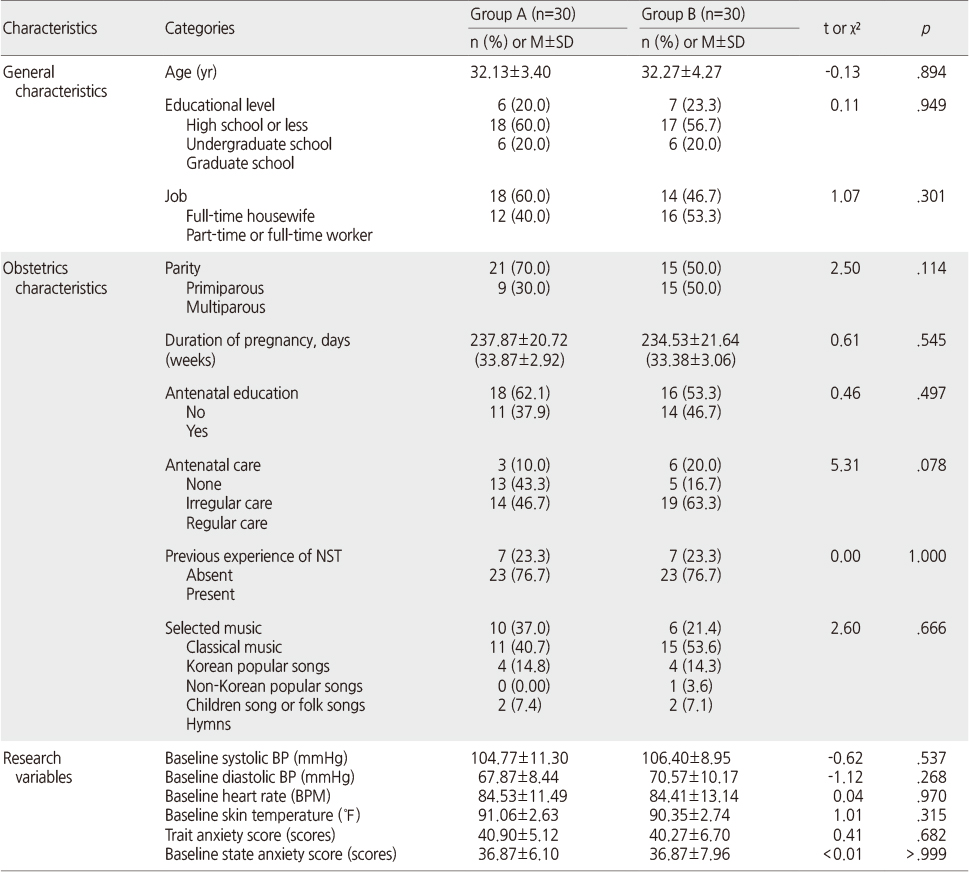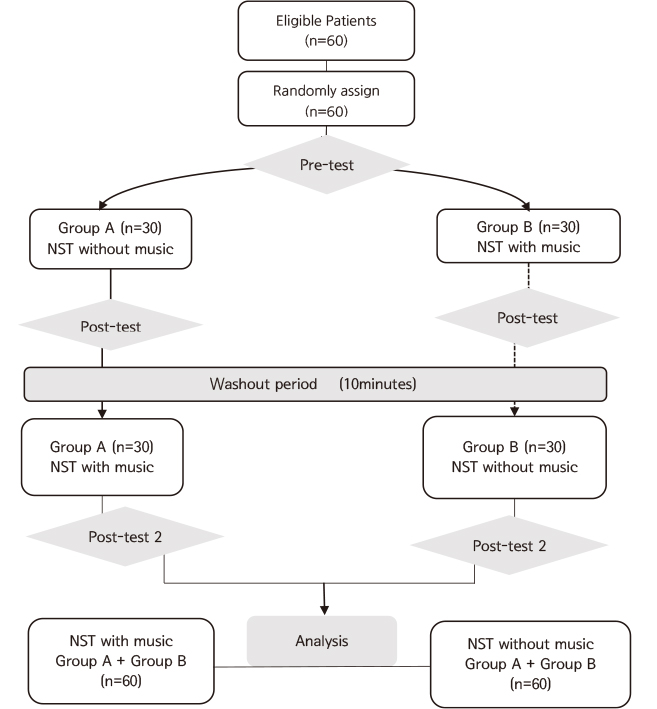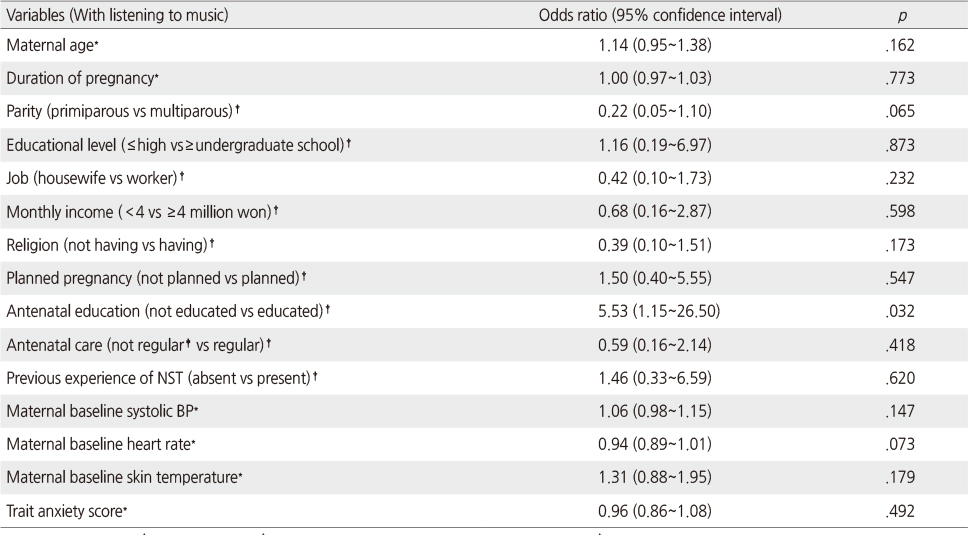Articles
- Page Path
- HOME > J Korean Acad Nurs > Volume 46(3); 2016 > Article
-
Original Article
- Effect of Music Intervention on Maternal Anxiety and Fetal Heart Rate Pattern During Non-Stress Test
- Myung Ok Oh, Young Jeoum Kim, Cho Hee Baek, Ju Hee Kim, No Mi Park, Mi Jeong Yu, Han Sol Song
-
Journal of Korean Academy of Nursing 2016;46(3):315-326.
DOI: https://doi.org/10.4040/jkan.2016.46.3.315
Published online: June 30, 2016
Department of Nursing, Korea University Medical Center Anam Hospital., Seoul, Korea.
- Address reprint requests to: Kim, Young Jeoum. Korea University Medical Center, 73, Inchon-ro, Seongbuk-gu, Seoul 02841, Korea. Tel: +82-2-920-5641, Fax: +82-2-921-5357, kyjiss72@naver.com
© 2016 Korean Society of Nursing Science
This is an Open Access article distributed under the terms of the Creative Commons Attribution NoDerivs License. (http://creativecommons.org/licenses/by-nd/4.0/) If the original work is properly cited and retained without any modification or reproduction, it can be used and re-distributed in any format and medium.
Abstract
-
Purpose
- The purpose of this cross-over experimental study was to examine effects of music intervention on maternal anxiety, fetal heart rate pattern and testing time during non-stress tests (NST) for antenatal fetal assessment.
-
Methods
- Sixty pregnant women within 28 to 40 gestational weeks were randomly assigned to either the experimental group (n=30) or control group (n=30). Music intervention was provided to pregnant women in the experimental group during NST. Degree of maternal anxiety and fetal heart rate pattern were our primary outcomes. State-trait anxiety inventory, blood pressure, pulse rate, and changes in peripheral skin temperature were assessed to determine the degree of maternal anxiety. Baseline fetal heart rate, frequency of acceleration in fetal heart rate, fetal movement test and testing time for reactive NST were assessed to measure the fetal heart rate pattern.
-
Results
- The experimental group showed significantly lower scores in state anxiety than the control group. There were no significant differences in systolic blood pressure and pulse rate between the two groups. Baseline fetal heart rate was significantly lower in the experimental group than in the control group. Frequency of acceleration in fetal heart rate was significantly increased in the experimental group compared to the control group. There were no significant differences in fetal movement and testing time for reactive NST between the two groups.
-
Conclusion
- Present results suggest that music intervention could be an effective nursing intervention for alel viating anxiety during non-stress test.
- 1. Chang MY, Chen CH, Huang KF. Effects of music therapy on psychological health of women during pregnancy. J Clin Nurs. 2008;17(19):2580–2587. 10.1111/j.1365-2702.2007.02064.x.ArticlePubMed
- 2. Yuksel F, Akin S, Durna Z. Prenatal distress in Turkish pregnant women and factors associated with maternal prenatal distress. J Clin Nurs. 2014;23(1-2):54–64. 10.1111/j.1365-2702.2012.04283.x.PubMed
- 3. Bradt J, Dileo C, Shim M. Music interventions for preoperative anxiety. Cochrane Database Syst Rev. 2013;6:CD00690810.1002/14651858.CD006908.pub2.Article
- 4. Siedliecki SL, Good M. Effect of music on power, pain, depression and disability. J Adv Nurs. 2006;54(5):553–562. 10.1111/j.1365-2648.2006.03860.x.ArticlePubMed
- 5. Lee JM, Hong HS. The effect of a preference music therapy on anxiety and pain of cystoscopy. J Korean Biol Nurs Sci. 2011;13(1):44–52.
- 6. Ovayolu N, Ucan O, Pehlivan S, Pehlivan Y, Buyukhatipoglu H, Savas MC, et al. Listening to Turkish classical music decreases patient's anxiety, pain, dissatisfaction and the dose of sedative and analgesic drugs during colonoscopy: A prospective randomized controlled trial. World J Gastroenterol. 2006;12(46):7532–7536. 10.3748/wjg.v12.i46.7532.ArticlePubMedPMC
- 7. Park MI, Shin DY, Chung KM, Lee YT, Hwang JH, Kim MY, et al. The effect of maternal hearing of "α-brain wave induced sound" and "natural sounds" on fetal heart rate in preterm and term pregnancies. Korean J Obstet Gynecol. 2000;43(8):1400–1406.
- 8. Shin HS, Kim JH. Music therapy on anxiety, stress and maternalfetal attachment in pregnant women during transvaginal ultrasound. Asian Nurs Res. 2011;5(1):19–27. 10.1016/s1976-1317(11)60010-8.Article
- 9. Mancuso A, De Vivo A, Fanara G, Denaro A, Laganà D, Accardo FM. Effects of antepartum electronic fetal monitoring on maternal emotional state. Acta Obstet Gynecol Scand. 2008;87(2):184–189. 10.1080/00016340701823892.ArticlePubMed
- 10. Kinsella MT, Monk C. Impact of maternal stress, depression and anxiety on fetal neurobehavioral development. Clin Obstet Gynecol. 2009;52(3):425–440. 10.1097/GRF.0b013e3181b52df1.ArticlePubMedPMC
- 11. Monk C, Fifer WP, Myers MM, Sloan RP, Trien L, Hurtado A. Maternal stress responses and anxiety during pregnancy: Effects on fetal heart rate. Dev Neuropsychol. 2000;36(1):67–77. 10.1002/(SICI)1098-2302(200001)36:1<67::AID-DEV7>3.0.CO;2-C.Article
- 12. Kafali H, Derbent A, Keskin E, Simavli S, Gözdemir E. Effect of maternal anxiety and music on fetal movements and fetal heart rate patterns. J Matern Fetal Neonatal Med. 2011;24(3):461–464. 10.3109/14767058.2010.501122.ArticlePubMed
- 13. Lee JW, Park MR, Lee JB, Lee SJ, Park ES, Park YJ. A review on the methods of sample size determination in nursing research. J Korean Acad Womens Health Nurs. 1998;4(3):375–387.ArticlePDF
- 14. Kim JT, Shin DK. A study based on the standardization of the STAI for Korea. New Med J. 1978;21(11):69–75.
- 15. Chang SB, Kim HS, Ko YH, Bae CH, An SE. Effects of abdominal breathing on anxiety, blood pressure, peripheral skin temperature and saturation oxygen of pregnant women in preterm labor. Korean J Women Health Nurs. 2009;15(1):32–42. 10.4069/kjwhn.2009.15.1.32..Article
- 16. Hankins GD, Miller DA. A review of the 2008 NICHD research planning workshop: Recommendations for fetal heart rate terminology and interpretation. Clin Obstet Gynecol. 2011;54(1):3–7. 10.1097/GRF.0b013e31820a015b.PubMed
- 17. Cito G, Luisi S, Mezzesimi A, Cavicchioli C, Calonaci G, Petraglia F. Maternal position during non-stress test and fetal heart rate patterns. Acta Obstet Gynecol Scand. 2005;84(4):335–338. 10.1111/j.0001-6349.2005.00644.x.ArticlePubMedPDF
- 18. Tucker SM, Miller LA, Miller DA. Mosby's pocket guide to fetal monitoring: A multidisciplinary approach. 6th ed. St. Louis, MO: Mosby; 2008.
- 19. Sjöström K, Valentin L, Thelin T, Marsál K. Maternal anxiety in late pregnancy: Effect on fetal movements and fetal heart rate. Early Human Dev. 2002;67(1-2):87–100. 10.1016/S0378-3782(01)00256-0.Article
- 20. Ventura T, Gomes MC, Carreira T. Cortisol and anxiety response to a relaxing intervention on pregnant women awaiting amniocentesis. Psychoneuroendocrinology. 2012;37(1):148–156. 10.1016/j.psyneuen.2011.05.016.ArticlePubMed
- 21. Yang M, Li L, Zhu H, Alexander IM, Liu S, Zhou W, et al. Music therapy to relieve anxiety in pregnant women on bedrest: A randomized, controlled trial. MCN Am J Matern Child Nurs. 2009;34(5):316–323. 10.1097/01.nmc.0000360425.52228.95.PubMed
- 22. Shahhosseini Z, Pourasghar M, Khalilian A, Salehi F. A review of the effects of anxiety during pregnancy on children's health. Mater Sociomed. 2015;27(3):200–202. 10.5455/msm.2015.27.200-202.ArticlePubMedPMC
- 23. Kane HS, Dunkel Schetter C, Glynn LM, Hobel CJ, Sandman CA. Pregnancy anxiety and prenatal cortisol trajectories. Biol Psychol. 2014;100:13–19.ArticlePubMedPMC
- 24. Simavli S, Gumus I, Kaygusuz I, Yildirim M, Usluogullari B, Kafali H. Effect of music on labor pain relief, anxiety level and postpartum analgesic requirement: A randomized controlled clinical trial. Gynecol Obstet Invest. 2014;78(4):244–250. 10.1159/000365085.ArticlePubMedPDF
- 25. Biddiss E, Knibbe TJ, McPherson A. The effectiveness of interventions aimed at reducing anxiety in health care waiting spaces: A systematic review of randomized and nonrandomized trials. Anesth Analg. 2014;119(2):433–448. 10.1213/ane.0000000000000294.PubMed
- 26. Pildner von Steinburg S, Boulesteix AL, Lederer C, Grunow S, Schiermeier S, Hatzmann W, et al. What is the "normal" fetal heart rate? PeerJ. 2013;1:e8210.7717/peerj.82.ArticlePubMedPMC
- 27. Monk C, Myers MM, Sloan RP, Ellman LM, Fifer WP. Effects of women's stress-elicited physiological activity and chronic anxiety on fetal heart rate. J Dev Behav Pediatr. 2003;24(1):32–38.ArticlePubMed
- 28. Akbarzade M, Rafiee B, Asadi N, Zare N. The effect of maternal relaxation training on reactivity of non-stress test, basal fetal heart rate, and number of fetal heart accelerations: A randomized controlled trial. Int J Community Based Nurs Midwifery. 2015;3(1):51–59.PubMedPMC
- 29. Allister L, Lester BM, Carr S, Liu J. The effects of maternal depression on fetal heart rate response to vibroacoustic stimulation. Dev Neuropsychol. 2001;20(3):639–651. 10.1207/s15326942dn2003_6.ArticlePubMed
- 30. Olesen AG, Svare JA. Decreased fetal movements: Background, assessment, and clinical management. Acta Obstet Gynecol Scand. 2004;83(9):818–826. 10.1111/j.0001-6349.2004.00603.x.ArticlePubMedPDF
REFERENCES
Homogeneity Test of General, Obstetrics Characteristics and Research Variables of Two Experimental Group (N=60)

Paired-Samples t-test for Clinical Data Measured Twice according to Listening to Music (N=60)

Figure & Data
REFERENCES
Citations

- The effect of spousal support during the non-stress test on the anxiety levels of pregnant women and fetal well-being: a randomized controlled study
Yeter Şener, Mürüvvet Başer
Advances in Mental Health.2025; : 1. CrossRef - The effect of virtual reality on pregnant women and fetuses: a systematic review and meta-analysis of randomized controlled trials
Xiaopu Shi, Chunguang Liang, Haitao Ren, Chunxia Liao, Na Yue
Archives of Gynecology and Obstetrics.2025; 312(2): 337. CrossRef - The effects of the pregnant woman’s mental visualization of her baby during the non-stress test on maternal anxiety and fetal parameters: A randomized controlled clinical trial
Fatma Keskin Töre, Cansu Ağralı, Gülçin Nacar, Özlem Özel Özcan
Advances in Integrative Medicine.2025; 12(4): 100508. CrossRef - The effect of virtual reality on fetal movement, fetal heart rate, maternal satisfaction, fatigue, and anxiety levels and vital signs of pregnant women during non-stress test: A randomized controlled trial
Eylem Toker, Mine Gökduman Keleş
Health Care for Women International.2024; 45(7): 765. CrossRef - The effects of listening to lullabies and self-selected music at home on prenatal stress and anxiety in nulliparous pregnant women: A randomized-controlled study
Nazlı Baltacı, Özlem Doğan Yüksekol, Emine Koç, Mihriban Ulucan
Health Care for Women International.2024; 45(5): 562. CrossRef - Fetuses can Listen, Learn, and Remember: We Need to be Cautious about What and How We Say It!
Akhil Maheshwari, Thierry AGM Huisman, Srijan Singh, Gayatri Athalye-Jape, Adrianna Frydrysiak-Brzozowska, Kedar Jape, Kinga Piórkowska
Newborn.2024; 3(4): 281. CrossRef - The effect of virtual reality and music on anxiety, non-stress test parameters, and satisfaction of high-risk pregnant women undergoing non-stress tests: Randomized controlled trial
Neslihan Yılmaz Sezer, Menekşe Nazlı Aker, Aykan Yücel, Dilan Çalışıcı
European Journal of Obstetrics & Gynecology and Reproductive Biology.2024; 296: 52. CrossRef - Effect of Virtual Reality and Music Therapy on the Physiologic Parameters of Pregnant Women and Fetuses and on Anxiety Levels: A Randomized Controlled Trial
Fatima Estrella‐Juarez, Mar Requena‐Mullor, Jessica Garcia‐Gonzalez, Antonia Lopez‐Villen, Raquel Alarcon‐Rodriguez
Journal of Midwifery & Women's Health.2023; 68(1): 35. CrossRef - Effectiveness of Music on Perinatal Anxiety Among Pregnant Women and Newborn Behaviors: A Systematic Review and Narrative Synthesis
Meena Konsam, Sonia R. B. D’Souza, Samir Kumar Praharaj, Baby S. Nayak, Jyothi Shetty, Shashikala Bhat, Judith A. Noronha, Sunita Panda
Indian Journal of Psychological Medicine.2023; 45(6): 565. CrossRef - Effects of music therapy on the fetal outcomes of non-stress test and maternal anxiety
L. Fathi, A. Shakarami, K. Amraei, F. Yari, A. Behzadvand
Neuropsychiatrie de l'Enfance et de l'Adolescence.2023; 71(6): 316. CrossRef - Environmental factors influencing women’s childbirth experiences in labor–delivery–recovery–postpartum unit: a qualitative cross-sectional study
Ashraf Kazemi, Marjan Beigi, Hajar Enteshary Najafabadi
BMC Pregnancy and Childbirth.2023;[Epub] CrossRef - The effect of music on fetal well-being and anxiety levels and vital signs of pregnant women during non-stress test: Turkey sample
Nurseli Soylu, Tülay Bülbül, İptisam İpek Müderris
Health Care for Women International.2022; 43(5): 499. CrossRef - Renkli Abdominal Örtü ve Kemer Kullanımının Non-Stress Test Parametreleri ve Maternal Kaygıya Etkisi: Randomize Kontrollü Bir Çalışma
Esra GÜNEY, Zeynep BAL, Esra KARATAŞ OKYAY, Tuba UÇAR
Samsun Sağlık Bilimleri Dergisi.2022; 7(2): 393. CrossRef - The Effect of a Breathing Relaxation Therapy for Pregnant Women with Preterm Labor Pain: a Systematic Review and Meta-Analysis
Seo-A Park
Keimyung Medical Journal.2021; 40(1): 39. CrossRef - Interventions among Pregnant Women in the Field of Music Therapy: A Systematic Review
Bruna Mayumi Omori Shimada, Magda da Silva Oliveira Menezes dos Santos, Mayara Alvares Cabral, Vanessa Oliveira Silva, Gislaine Cristina Vagetti
Revista Brasileira de Ginecologia e Obstetrícia / RBGO Gynecology and Obstetrics.2021; 43(05): 403. CrossRef - The effectiveness of music on the result of non-stress test
Tuan Vo, Anh Huynh, Thao Nguyen Thi Thu, Lora Claywell
MedPharmRes.2020; 4(3): 12. CrossRef - The Effect of Music on Fetus Movement During Non-Stress Test
Batoul Khodakarami, Marzieh Janesari Ladani, Farideh Kazemi, Soudabeh Aghababaei
Avicenna Journal of Nursing and Midwifery Care.2020; 28(4): 1. CrossRef - The effect of music on the non-stress test and maternal anxiety
Hatice Erkun Dolker, Fatma Basar
Complementary Therapies in Clinical Practice.2019; 35: 259. CrossRef - Müziğin non-stres test üzerine etkilerinin incelenmesi
Ramazan DENİZLİ, Nayif ÇİÇEKLİ, Gökhan GÜLYAŞAR, Yasmin ABOALHASAN, Taylan AYGÜN, Nihat FARİSOĞULLARI, Önder SAKİN
SDÜ Tıp Fakültesi Dergisi.2019; 26(4): 464. CrossRef - The effect of music on the results of a non-stress test: A non-randomized controlled clinical trial
Didem Şimşek Küçükkelepçe, Sermin Timur Taşhan
European Journal of Integrative Medicine.2018; 18: 8. CrossRef - The effect of traditional Persian music on the cardiac functioning of young Iranian women
Behzad Abedi, Ataollah Abbasi, Atefeh Goshvarpour, Hamid Tayebi Khosroshai, Elnaz Javanshir
Indian Heart Journal.2017; 69(4): 491. CrossRef

Figure 1
Homogeneity Test of General, Obstetrics Characteristics and Research Variables of Two Experimental Group (N=60)
BP=Blood pressure; BPM=Beats per minute; NST=Non-stress test; M=Mean; SD=Standard deviation; independent-samples t-test (continuous variables); χ2 test or Fisher's exact test (categorical variables).
Paired-Samples t-test for Clinical Data Measured Twice according to Listening to Music (N=60)
*When a final interpretation of NST was non-reactive, minimum time to reactive NST was decided 20 minutes; BP=Blood pressure; BPM=Beats per minute; NST=Non-stress test; M=Mean; SD=Standard deviation.
Logistic Regression Analysis on Prediction for Decrease of State Anxiety Score in Pregnant Women Listening to Music (N=60)
*Continuous variables; †Binomial variables; ‡'Not regular' indicated 'no care'as well as 'irregular care'; †Dummy variable: 1=multiparous; 1='≥undergraduate school'; 1=worker; 1='≥4 million won'; 1=having; 1=planned; 1=educated; 1=regular; 1=present; BP=Blood pressure; NST=Non-stress test.
Multiple Regression Analysis on Estimation for Change of Fetal Acceleration according to Listening to Music* (N=60)
*: 'Change of X' was defined as 'X with listening to music'minus 'X without listening to music'; BP=Blood pressure; SE=Standard error.
BP=Blood pressure; BPM=Beats per minute; NST=Non-stress test; M=Mean; SD=Standard deviation; independent-samples t-test (continuous variables); χ2 test or Fisher's exact test (categorical variables).
*When a final interpretation of NST was non-reactive, minimum time to reactive NST was decided 20 minutes; BP=Blood pressure; BPM=Beats per minute; NST=Non-stress test; M=Mean; SD=Standard deviation.
*Continuous variables; †Binomial variables; ‡'Not regular' indicated 'no care'as well as 'irregular care'; †Dummy variable: 1=multiparous; 1='≥undergraduate school'; 1=worker; 1='≥4 million won'; 1=having; 1=planned; 1=educated; 1=regular; 1=present; BP=Blood pressure; NST=Non-stress test.
*: 'Change of X' was defined as 'X with listening to music'minus 'X without listening to music'; BP=Blood pressure; SE=Standard error.
 KSNS
KSNS
 E-SUBMISSION
E-SUBMISSION



 Cite
Cite

